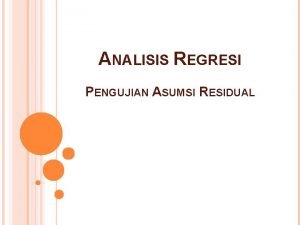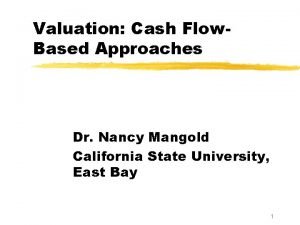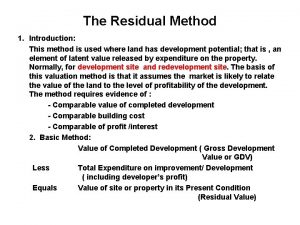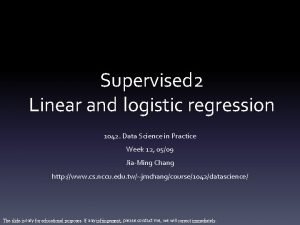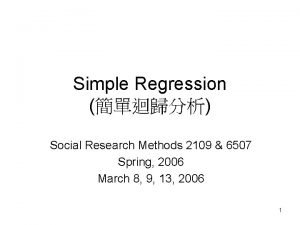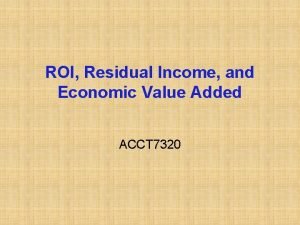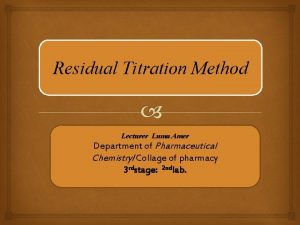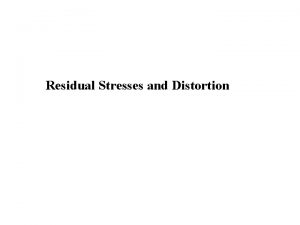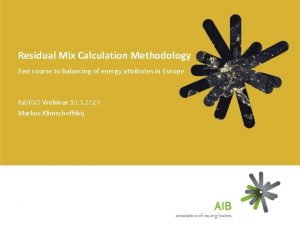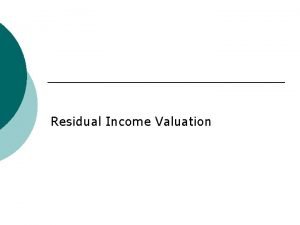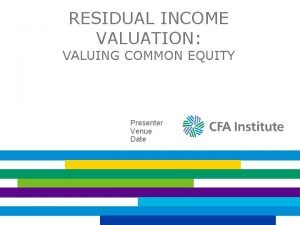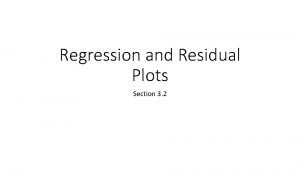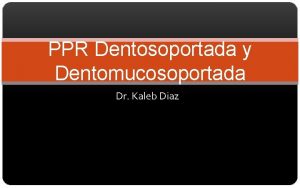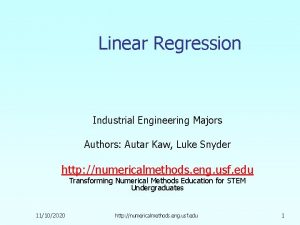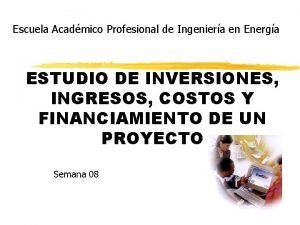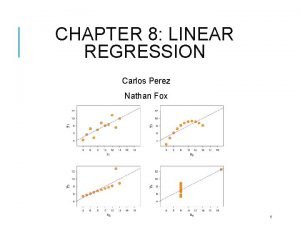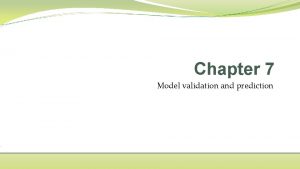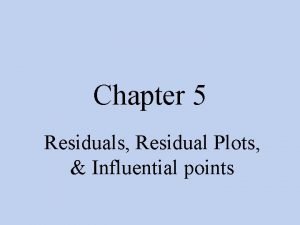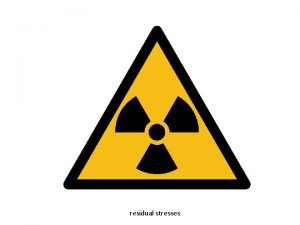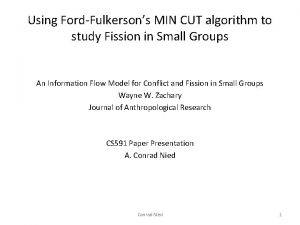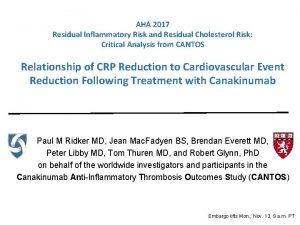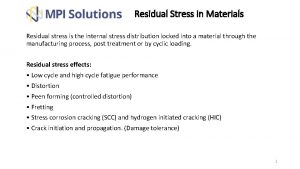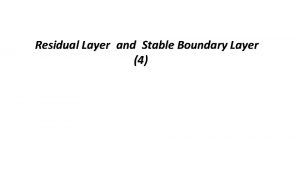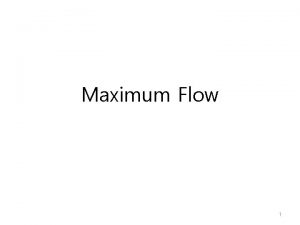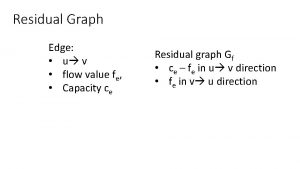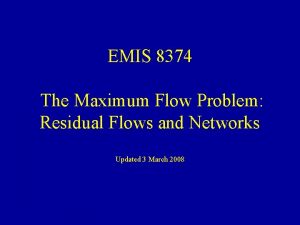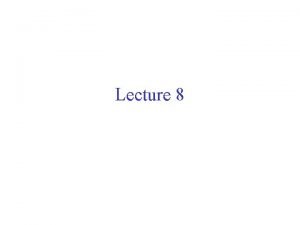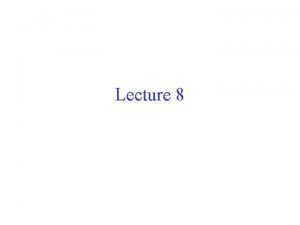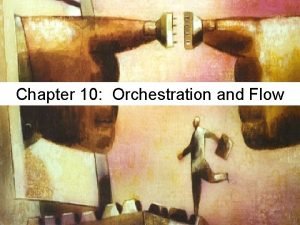Flow Networks Topics Flow Networks Residual networks FordFulkersons





























- Slides: 29

Flow Networks Topics Flow Networks Residual networks Ford-Fulkerson’s algorithm Ford-Fulkerson's Max-flow Min-cut Algorithm Chapter 7 Algorithm Design Kleinberg and Tardos 2/1/2022 CSE 5311 Kumar 1

Flow Networks A directed graph can be interpreted as a flow network to analyse material flows through networks. Material courses through a system from a source (where it is produced) to a sink (where it is consumed). Examples : Water through pipelines Newspapers through distribution system Electricity through cables Cars on a production line on roads The source produces the material at a steady rate. The sink consumes the. CSE material 2/1/2022 5311 Kumarat a steady rate 2

Flow: the rate at which the material moves from one point to another 100 litres of water per hour in a pipe 30 Amperes of electric current in a circuit 25 litres/hour 30 liters/hour The rate at which a material enters a vertex = the rate at which the material leaves the vertex 2/1/2022 CSE 5311 Kumar 3

The flow network G =(V, E) is a directed graph in which each edge (u, v) E has a nonnegative capacity c(u, v) 0. If (u, v) E then c(u, v) = 0. A flow network has a source vertex s, and a sink vertex t. For every vertex v V there is a path from s to v and v to t in a connected graph. s t source 2/1/2022 sink CSE 5311 Kumar 4

A flow in G is a real-valued function f : V V R that satisfies the following three properties: 1. Capacity constraint : For all u, v V, we require f(u, v) c(u, v). The net flow from one vertex to another must not exceed the given capacity. 2. Skew symmetry : For all u, v V, we require f(u, v) = -f(v, u). The net flow from a vertex u to a vertex v is the negative of the net flow in the reverse direction. The net flow from a vertex to itself is zero for all u V, that is f(u, u) = 0. 3. Flow conservation : For all u V - {s, t}, we require The total net flow out of a vertex other than the source or sink is zero. 2/1/2022 CSE 5311 Kumar 5

The quantity f(u, v) can be negative or positive, it is called the net flow from vertex u to v. The value of a flow is defined as In the maximum-flow problem, we are given a flow network G with source s and sink t, and we wish to find a flow of maximum value from s to t. There is no net flow between u and v if there is no edge between them. If (u, v) E and (v, u) E, then c(u, v) = c(v, u) = 0. Hence, the capacity constraint, f(u, v) 0 and f(v, u) 0. By skew symmetry, f(u, v) = -f(v, u), therefore, f(u, v) + f(v, u) = 0. Nonzero net flow from vertex u to vertex v implies that (u, v) E or (v, u) E (or both). 2/1/2022 CSE 5311 Kumar 6

Consider the network G=(V, E) shown in the figure below. The network is for a transport system that transports crates of an item from source vertex s to sink vertex t through a number of intermediate points. Each edge (u, v) E in the network is labeled with its capacity c(u, v). a 20 16 10 s c 12 4 9 7 13 4 b 2/1/2022 t 14 d CSE 5311 Kumar 7

Let us consider a flow in G, f =19 If f(u, v) >0, edge (u, v) is labeled f(u, v)/c(u, v) If f(u, v) 0, the edge is labeled by its capacity only. a 12/12 c 15/20 11/16 1/4 s 4/9 10 7/7 8/13 4/4 b 2/1/2022 t 11/14 CSE 5311 Kumar d 8

The positive net flow entering a vertex v is defined by Initially, c (a , b) = 8, and c (b, a) = 3 -- Fig. a. f (a, b) = 5 and f (b, a) = 2, -- Fig. b the net flow is shown as 3/8 in direction a to b – Fig. c a a 8 3/8 5/8 2/3 3 2/1/2022 a 3 b b b Fig. a Fig. b Fig. c CSE 5311 Kumar 9

a a 8 a a 3/8 5/8 8 2/3 3 3 1/3 b b Fig. a Fig. b Fig. c Fig. d If we increase the flow from b to a from 2 to 6 then the net flow is 1/3 in the direction b to a as shown in Fig. d. 2/1/2022 CSE 5311 Kumar 10

The Ford_Fulkerson method The method is iterative, Starts with f(u, v) for (u, v) V, initial flow of value 0. The method is based on the augmenting path which is defined as a path from s to t along which we can push more flow and then augment flow along this path. Procedure Ford_Fulkerson_method(G, s, t) 1. f 0; 2. while there exists an augmenting path p 3. do augment flow along path p 4. return f 2/1/2022 CSE 5311 Kumar 11

Residual Networks Consider a flow network G(V, E) with source s and sink t and let f be a flow in G. Consider a pair of vertices u, v V. Residual capacity between u and v is given by r(u, v) = c(u, v) - f(u, v) nthe additional net flow we can push from u to v before exceeding the capacity. For example, if c(u, v) = 25 and f(u, v) = 19, then r(u, v) = 6. If f(u, v) < 0 then r(u, v) > c(u, v) Given a flow network G=(V, E) and a flow f, the residual network of G induced by f is Gf=(V, Ef), where Ef ={(u, v) V V : r(u, v) > 0} 2/1/2022 CSE 5311 Kumar 12

a 12/12 c 15/20 11/16 1/4 s 10 4/9 a 7/7 8/13 11/14 d c 5 5 t 5 11 s 4/4 b 12 3 7 4 5 11 8 15 3 4 t 4 11 d b Each edge in the residual network can admit positive net flow only. The residual network may include several edges that are not in the original network, (u, v) Ef and (u, v) E is possible (Ef is not a subset of E). However, (u, v) appears in Gf only if (v, u) E and there is a positive flow from v to u. Because the net flow f(u, v) is negative, r(u, v) = c(u, v)-f(u, v) > 0 and (u, v) Ef 2/1/2022 CSE 5311 Kumar 13

An edge (u, v) can appear in a residual network only if at least one of (u, v) and (v, u) appears in the original network. Ef 2 E Augmenting Paths It is a simple path from s to t in Gf. Each edge (u, v) on an augmenting path admits some additional positive net flow from u to v without violating the capacity constraint on the edge. The residual capacity of a path p is given by, r(p) = min { r(u, v) : (u, v) is in p } 2/1/2022 CSE 5311 Kumar 14

Let's define a flow function fp, fp is a flow in Gf with value fp = r(p) >0. If we add fp to f, we get another flow in G whose value is closer to the maximum. 2/1/2022 CSE 5311 Kumar 15

Algorithm Procedure Ford-Fulkerson(G, s, t) Input : Flow Network G(V, E) Output : Maximum flow for the given network 1. for each edge (u, v) E 2. do f[u, v] 0; 3. f[v, u] 0; 4. while there exists a path p from s to t in the residual network Gf 5. do r(p) min {r(u, v) : (u, v) is in p}; 6. for each edge (u, v) in p 7. do f[v, u] - f[u, v]; 8. f[u, v] + r(p); 9. return 2/1/2022 CSE 5311 Kumar 16

a 20 16 10 s c 12 4 9 7 t 13 4 b 14 d a 4/12 c 20 4/16 4 s 7 4/9 10 4/4 13 b 2/1/2022 t CSE 5311 Kumar 4/14 d 17

a c 4/12 20 4/16 4 s 7 4/9 10 4/4 13 4/14 b a a 4 4 13 4 5 7 4 4 s t 7/10 c 7/20 7/7 4/9 b d CSE 5311 Kumar t 4/4 13 4 10 4/12 d 11/16 20 10 b 2/1/2022 8 4 12 s c t 11/14 d 18

a c 4/12 7/20 11/16 4 s 7/7 4/9 7/10 4/4 13 11/14 b a 11 11 13 4 5 7 3 2/1/2022 11 7 4 3 b a 13 4 5 s c 8 12/12 1/4 10 15/20 7/7 4/9 b CSE 5311 Kumar t 4/4 8/13 d d c 11/16 t s t 11/14 d 19

a c 12/12 15/20 11/16 1/4 s 5 11 s 4 5 3 5 7 8 b 11 d t 4 3 11/14 b 15 a 12/12 c 19/20 11/16 d 1/4 s 10 7/7 4/9 b CSE 5311 Kumar t 4/4 12/13 2/1/2022 t 4/4 8/13 5 12 11 10 c a 7/7 4/9 11/14 d 20

a 12/12 c 19/20 11/16 1/4 s 10 7/7 4/9 t 4/4 12/13 b 11/14 c a d 5 11 11 s 9 3 1 1 12 7 12 2/1/2022 CSE 5311 Kumar 11 t 4 3 b 19 d 21

Complexity of the algorithm • Number of iterations of the while loop – All capacities are integers • Amount of work in each iteration of the while loop – Number of edges in the graph 2/1/2022 CSE 5311 Kumar 22

Minimum Cuts Cut (S, T) of a flow network A cut (S, T) of a flow network G=(V, E) is a partition of V in to S and T = V S such that s S and t T. In the example: 19 7/7 10 v 3 /20 1/4 16 11/ 12/ 13 v 2 11/14 S v 4 S = {s, v 1, v 2) , T = {v 3, v 4, t} t 0/9 S 12/12 v 1 Net flow f (S , T) = f (v 1, v 3) + f (v 2, v 4) + f (v 2, v 3) = 12 + 11 + (-0) = 23 4/4 Capacity c(S, T) = c(v 1, v 3) + c(v 2, v 4) = 12 + 14 = 26 T f (S, T) = f (u, v) u S 2/1/2022 v T CSE 5311 Kumar 23

Ford Fulkerson – cuts of flow networks Assumption: The value of any flow f in a flow network G is bounded from above by the capacity of any cut of G | f | < c (S, T) < c (u, v) u S v T = c (S, T) 2/1/2022 S v 3 19 /20 7/7 u S v T 16 / 1 1 12/12 t 0/9 = f (u, v) v 1 1/4 | f | = f (S, T) 10 Lemma: 12/ 13 CSE 5311 Kumar v 2 11/14 v 4 4/4 25

• • • Suppose that each source si in a multisource, multisink problem produces exactly pi units of flow, so that f(si, V) = pi. Suppose that each sink tj consumes exactly qj units so that f(V, tj) = qj, where. Show to convert the problem of finding a flow f that obeys these additional constraints into the problem of finding a maximum flow in a single-source, single-sink flow network. Given a flow network G = (V, E), let f 1 and f 2 be functions from V V to R. The flow sum f 1 + f 2 is the function from V V to R defined by (f 1 + f 2)(u, v) = f 1(u, v) + f 2(u, v) for all u, v V. If f 1 and f 2 are flows in G, which of the three flow properties must the flow f 1 + f 2 satisfy, and which might it violate? The edge connectivity of an undirected graph is the minimum number k of edges that muct be removed to disconnect the graph. For example, the edge connectivity of a tree is 1, and the edge connectivity of a cyclic chain of vertices is 2. Show that how the edge connectivity of an undirected graph G = (V, E) can be determined by running a maximumflow algorithm on at most V flow networks, each having O(V) vertices and O(E) edges. 2/1/2022 CSE 5311 Kumar 28

Bipartite Matching • Finding a matching M in G of largest size • A bipartite graph G = (V, E) is an undirected graph whose node set is partitioned into two sets X and Y such that V = X Y. Every edge e E has one end in X and the other end in Y. • A matching M in G is a subset of the edges M E such that each node v V appears in at most one edge in M. 2/1/2022 CSE 5311 Kumar 29

Bipartite graph and Flow Network s t u v Each edge has a capacity of ONE 2/1/2022 CSE 5311 Kumar 30

s s t t t v 1 -u 1 v 2 -u 3 t v 3 -u 5 v 5 -u 4 2/1/2022 CSE 5311 Kumar 31

2/1/2022 CSE 5311 Kumar 32
 Residual dalam statistik adalah
Residual dalam statistik adalah Residual cash flow
Residual cash flow Phasets
Phasets Datagram switching vs virtual circuit switching
Datagram switching vs virtual circuit switching Backbone networks in computer networks
Backbone networks in computer networks Residual method example
Residual method example Residual properties in thermodynamics
Residual properties in thermodynamics Logistic regression residual deviance
Logistic regression residual deviance Regression
Regression Economic value added
Economic value added Residual titration คือ
Residual titration คือ Distortion
Distortion Atwood's classification of residual ridges
Atwood's classification of residual ridges Residual mix
Residual mix Residual income valuation
Residual income valuation Residual income valuation
Residual income valuation Calculate residual income
Calculate residual income How to find residual on ti-84
How to find residual on ti-84 Residual drawdown
Residual drawdown Residual risk and secondary risk pmp
Residual risk and secondary risk pmp Dentomucosoportada y dentosoportada
Dentomucosoportada y dentosoportada Riesgos estrategicos
Riesgos estrategicos When x = 4, what is the residual? –3 –1 1 3
When x = 4, what is the residual? –3 –1 1 3 Residual standard error
Residual standard error Valor de desecho metodo economico
Valor de desecho metodo economico Inercia
Inercia Deep residual learning for image recognition
Deep residual learning for image recognition Negative residual meaning
Negative residual meaning Standard error of prediction
Standard error of prediction Section 10 topic 5 residuals and residual plots
Section 10 topic 5 residuals and residual plots
